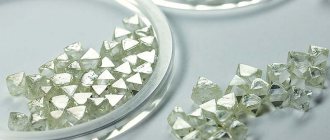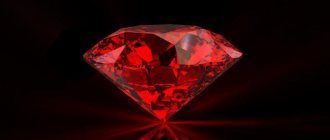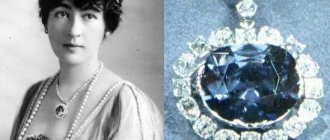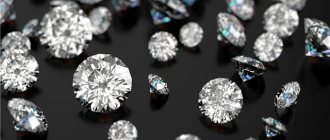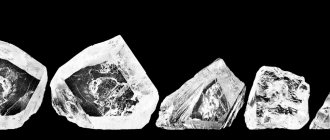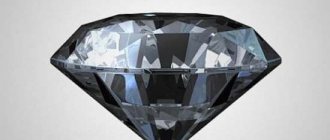A whole motorcade of limousines delivers Lev Leviev to Zhitomir. There he is greeted with an orchestra and traditional Hasidic dances. In the local Lubavitcher community—and four hundred others throughout the former USSR—Levaev is known as a benefactor. The 48-year-old Israeli transfers $30 million a year to the needs of Orthodox Jews in his former homeland. But at the headquarters of the diamond corporation De Beers, which in the industry is simply called the Syndicate, Leviev is considered his worst enemy. He was once a sightholder, a member of the small elite to whom De Beers sells diamonds directly. Now he is not only the world's largest cutter, but also a supplier of diamonds to other cutters and jewelers. Those who watched his 30-year rise to the top of the business say Leviev was driven by a personal hatred of De Beers. He was haunted by the Syndicate’s unceremonious treatment of customers: they were offered boxes of rough diamonds of varying quality, but it was impossible to bargain - those who were uncompromising could have their supplies cut off.
Now Leviev avoids openly criticizing his former partners from South Africa. But he cannot hide his attitude towards De Beers: “No one will tell me how to do business. I grew up in the Soviet Union. I know what fear is. I remember being beaten at school. Even then I told myself that I would never be afraid of anyone again.”
Indeed, Leviev took away a considerable amount of business from De Beers in Russia and Angola, the largest diamond producing countries. His example inspired others. In particular, the Russian diamond mining company, a loyal partner of De Beers, sold $100 million worth of diamonds last year, bypassing the corporation. If five years ago the Syndicate accounted for 80% of the world diamond market, now it is 60%.
Advertising on Forbes
Leviev began working directly with the governments of diamond-producing countries, and this gave him the opportunity to create the industry's first vertically integrated holding. Profiting at every stage of the value chain, Leviev became a very rich man. He owns 100% of the Lev Leviev Group and a controlling stake in the Africa Israel Investments conglomerate, which has real estate in Prague, London and Moscow, the Gottex swimwear company, 1,700 gas stations in the southwestern United States, 173 7- 11" in the states of New Mexico and Texas, 33% of the Cross Israel Highway company, which controls the first toll highway in Israel, as well as 85%, which organized Russian-language television broadcasting in Israel. Leviev has a gold mine in Kazakhstan, shares in the diamond mines of Angola, and licenses for diamond mining in Namibia. His personal fortune is estimated at $2 billion.
This wealth was largely created through political connections, which is why many view Leviev with distrust and even hostility. In a recent example, when a businessman was preparing to acquire a 40 percent stake in Australia's Argyle diamond mines, the banks he was counting on pulled out at the last minute. Forbes sources claim that the matter is the opacity of Levi’s business. Even if Leviev himself is clean, he often deals with people whose hands are up to their elbows in mud. It’s not for nothing that he maintains a whole brigade of bodyguards.
Smuggling from Uzbekistan
In the Jewish community, many dislike Leviev because he harshly defends the interests of the Hasidic branch of Judaism. He secured Russian citizenship from President Putin for Lubavitcher rabbi Berel Lazar, who was born in Italy and studied in the United States, and within days made him chief rabbi of Russia, pushing aside Adolf Shaevich. As the unofficial leader of Russian Jews, Leviev suits Putin much more than Vladimir Gusinsky, who supported Shaevich. “We Jews often try to influence the authorities for our own personal interests,” Leviev said in an interview with the Jewish Telegraphic Agency. “I believe that members of the public are prohibited from mixing personal business interests with community interests.” Putin himself couldn't have said it better.
Leviev met Putin back in 1992, when he was the St. Petersburg vice-mayor. Putin approved the opening of a Jewish school in the city, financed by Leviev, although Mayor Anatoly Sobchak was hesitant at the time. In the same era, Leviev became a kind of mediator between Israel and the Central Asian countries of the former USSR, he persuaded the secular dictators of these countries to participate in the fight against Islamic fundamentalism. Leviev now lives in Israel, in B'nai Brak, a settlement of ultra-Orthodox Jews, and maintains close ties with Prime Minister Ariel Sharon, the presidents of Angola and Namibia, Jose Eduardo Dos Santos and Sam Nujoma, as well as with Nursultan Nazarbayev and Islam Karimov.
Lev Leviev grew up in Uzbekistan, in Tashkent. His father Avner was a Lubavitcher rabbi, and all the men in the family, including Lev, knew how to perform circumcision. Avner traded in textiles and collected Persian carpets. In Soviet Uzbekistan, he managed to amass a fortune of $1 million, which in 1971, before the family left for Israel, he converted it into diamonds and smuggled it out of the USSR. However, when he tried to sell diamonds in Israel, he was explained that the stones were of low quality and cost only $200,000. Fifteen-year-old Lev vowed to pay back the diamond traders. He left the yeshiva, a religious academy, and began cutting diamonds.
De Beers challenge
Lev Leviev opened his own cutting plant in 1977, when unregulated diamond speculation began in Israel. Cutters invested in diamonds, counting on further price increases. But three years later the market collapsed, banks stopped lending to diamond dealers and many cutters went bankrupt.
Leviev, on the other hand, did not take out loans on the security of reserves and in five years expanded his business to 12 small industries. In search of raw materials, he often visited London, Antwerp, Johannesburg, and Yakutsk. He began to use laser technologies for diamond processing and introduce special software - a revolutionary step in those days. Its craftsmen have learned to simulate various cutting options on a computer, taking into account the individual characteristics of the stone. “His genius was in adapting the latest technology to specific market needs,” says Charles Wyndham, co-founder of WWW International Diamond Consultants.
In 1987, De Beers invited Leviev to become a sightholder - to become one of the selected buyers of its diamonds. By that time he was already one of the largest diamond producers. And two years later, Soviet Russia, trying to transfer the cutting industry to market footing and set an example for its producers, asked Leviev for help. So in 1990, the Ruiz Diamonds joint venture was created in Moscow. Leviev’s partner was the division of Glavalmazzoloto, which united all Soviet enterprises in the diamond industry. Now Leviev has 100% and two cutting production facilities in the territory of the former USSR: in Perm and Armenia.
Leviev developed a warm relationship with Valery Rudakov, who headed Glavalmazzoloto during the Gorbachev era. Soon the doors of the Kremlin opened for Leviev. “I never talked about business with Gorbachev,” says Leviev. “I talked to him about opening Jewish schools where there had been none for 70 years.” But, most likely, it was cooperation with Leviev that helped the Soviet side understand that De Beers was purchasing Russian diamonds at reduced prices compared to world prices.
A simple intimate gift
The purpose of these marketing moves was extremely simple. The public had to purchase as many diamonds from the world's deposits as possible. In addition, she had to be convinced not to resell her stones. That is, it was necessary to romanticize the idea of keeping your jewelry, the idea of \u200b\u200bfidelity to them. The number of diamonds mined increased rapidly, and new mines appeared every year. If jewelry owners began to regularly resell their stones, this would ultimately cause the new infusions to depreciate in value. Therefore, Ayer made the romantic overtones the primary aspect of the creative, as opposed to the economic value of the diamonds. The slogan “A diamond is forever” seems to say that although a diamond is a good investment, this stone should not be resold, at least for sentimental reasons.
Huge amounts of money were invested in advertising. Hundreds of influential actors, actresses and models convinced representatives of the upper-middle class: buy diamonds. The skepticism of the powers that be was not broken immediately. Diamonds came into fashion only in the 60s, when De Vire had free funds, and therefore the ability to regulate potential markets.
De Beers' marketing strategy had another important aspect, the implementation of which no advertising agency could help - to preserve the image of diamonds as a stable reserve of value. Two tactics were used. The first regulated a relatively constant supply of diamonds. Such that the price of diamonds never decreases. The second kept stones at a certain level of quality and size when market demand fell, and - just as important - ensured the necessary supply when demand was high. If these conditions were not met, then in a situation of falling demand, inflation would exceed all reasonable limits. Conversely, the rapid rise in prices could make some owners want to sell their diamonds for a quick profit.
De Beers advertisement, 1956
De Beers advertisement, 1961
De Beers advertisement, 1974
In the 50s De Beers advertising reached Great Britain, France and Germany. And in 1967, advertisements for diamonds were placed for the first time in Japan. In the early 1960s, before De Beers entered the Land of the Rising Sun, only one in 20 Japanese brides wore a diamond engagement ring. Now this figure is 70%.
In 1982, advertising campaigns expanded to East Asia, Singapore, the Philippines, Malaysia, Thailand and Taiwan. Increased demand in the region was necessary to develop new products from the Jwaneng and Argyle mines in Australia, which began producing huge quantities of small, inexpensive diamonds in 1983.
To increase sales, in 1988 De Beers initiated a revival of the old tradition. The bride wore a diamond garter on her 10th wedding anniversary. Since then, the number of women wearing a garter has almost quadrupled.
De Beers advertising, launched in 1995 with the familiar slogan “A Diamond is Forever,” is so much more fashionable and elevated than gold. Target positioning was based on the following basis: a woman as an independent buyer or a husband who wants to please his wife. The second target was preferable. There were two commercials on television, “Architect” and “Hotel.”
Print advertising focused on creating an image that a woman could easily compare to close and familiar things. Information on diamond testing belonged to the “scientific note” genre. These steps changed the way viewers and readers viewed this gem. In 1997, according to the results of sociological surveys, it strengthened its non-traditional brand, which by 1997 the diamond market increased by 19.4%. The advertising idea was this: diamonds have finally moved into the category of simple intimate gifts.
Where did the Russian diamonds go?
The deal with Glavalmazzoloto provided Leviev with access to Russian raw materials and angered De Beers. By 1995, the Syndicate didn’t want to hear any more about this upstart. Leviev was excluded from the number of sightholders. It is believed that he expected this step and secured supplies of raw materials from the Russian Gokhran. The Yeltsin government, having sold its main oil and metallurgical assets on the cheap, decided to replenish the empty treasury by selling state diamond reserves accumulated since 1955. According to Chaim Even-Zohar, who publishes the influential magazine Diamond Intelligence Briefs in Israel, in the early 90s these reserves were worth $12 billion. It is believed in the industry that the Soviet diamond inheritance was sold, including through Leviev. The inheritance included huge stones weighing 100 carats or more, says Richard Wake-Walker of WWW International Diamond Consultants. By 1997, a significant part of Russian reserves had been sold off. And some were simply stolen. I remember the story of Golden ADA, when diamonds worth $180 million, supplied from Russia supposedly for processing at a factory in the vicinity of San Francisco, disappeared without a trace. Leviev denies that he participated in the sale of Russian diamond reserves. “This is cheap gossip,” he snapped in an interview with Forbes.
By 1998, Leviev had already received a percentage of Russian diamond mining: by his decree, Yeltsin ordered that diamonds mined in the Perm region be cut at local enterprises, among which was only Leviev’s Kama-Crystal. Leviev held a monopoly on Perm diamonds for five years - the decree was canceled only last fall.
Whatever Leviev did during Yeltsin’s reign, he tried to keep a low profile and was not included in the list of the ex-president’s “family.” Leviev managed to quickly establish relations with President Putin: he organized the first meetings of the new Russian leader with prominent Israeli politicians.
Notes
- ↑ 12
[bfm.ru/news/2009/02/20/chistaja-pribyl-de-beers-za-2008-god-90-mln-dollarov.html De Beers’ net profit for 2008 is $90 million] - “Lev Leviev, tous les diamants du monde”, Les échos (ISSN 0153 4831), No. 20216 dated 07/22/2008
- [www.investopedia.com/financial-edge/1111/8-Of-The-Most-Successful-Ad-Campaigns-Of-All-Time.aspx|8 Of The Most Successful Ad Campaigns Of All Time]
- [lenta.ru/news/2011/11/04/debeers/ British miners will gain control of De Beers for $5 billion]. // lenta.ru. Retrieved November 4, 2011. [www.webcitation.org/65cjPPLbW Archived from the original on February 21, 2012].
- [www.debeersgroup.com/en/our-story/group-structure.html Our shareholders]
- ↑ 1 2 Ksenia Rybak, Maria Plis
. De Beers on Red Square // Vedomosti, No. 161 (1935), August 29, 2007
"Bloody" stones
Leviev created problems for De Beers not only in Russia, but also in the Syndicate’s home region - Africa. In the mid-1990s, the diamond-producing regions of Angola, the world's third-largest supplier of stones, were controlled by UNITA, rebels trying to overthrow President Dos Santos. To get money for weapons, the rioters threw $1.2 billion a year worth of diamonds onto the market. De Beers had no choice: in order not to lose control over world prices, these stones had to be bought up. The London-based group of human rights activists Global Witness notified the world about this: “blood” diamonds have turned into a PR nightmare for De Beers. In 1998, the UN imposed sanctions on the purchase of diamonds from Angolan rebels, and De Beers closed its purchasing offices in Angola.
Leviev made his mark in Angola in 1996, paying $60 million for 16% of the country's largest diamond mine, which was recaptured from rebels by government forces. Leviev hired former Israeli intelligence officers to guard the mines. ALROSA, which also owned a share in the mine, was unable to help its African partner in any way. “Dos Santos says that I was the only one who helped his country,” Leviev says now. For this, the president gave him the exclusive right to purchase Angolan diamonds.
They say Leviev and Dos Santos initially hit it off because they both speak Russian and hate De Beers. In addition, the Israeli promised the President of Angola to sharply increase tax revenues from diamond mining, and at the same time transferred 51% of the shares of Angola Selling Corp. to the government of the country. (Ascorp) - a newly created exclusive buyer of local rough stones. There are industry whispers that Dos Santos' daughter Isabella also has a stake in the company. Leviev claims that he knows nothing about this.
Advertising on Forbes
Leviev kept his promises to Dosso Santos only partially. Tax revenues from the sale of diamonds actually jumped in 2002 to $62 million (in 1998 it was $10 million). Leviev had to purchase Angolan diamonds worth $1 billion a year - not an easy task. As a result, he ended up with too many stones, he was forced to sell them cheaply and could not provide consistently high purchasing prices to manufacturers. Perhaps this is why Leviev lost the exclusive right to sell Angolan diamonds a year ago. True, he himself warns: “It’s too early to count me out.”
Activity
The company's mines in South Africa, and in partnership with the governments of Botswana, Namibia and Tanzania, produce approximately 40% of the world's diamonds.[6] Since 2001, the company has also been active in the retail diamond and jewelry market (the stores are owned by a joint venture with LVMH Moët Hennessy - Louis Vuitton (LVMH) - De Beers Diamond Jewelers).
Performance indicators
De Beers operates in 25 countries. The total number of personnel is 22.9 thousand people, 17 thousand work in southern Africa.
In 2005, De Beers enterprises produced 51 million carats of diamonds.[6] Revenue in 2008 increased by 0.8% to $6.89 billion, net profit - $90 million (in 2007, a loss of $482 million).[1]

